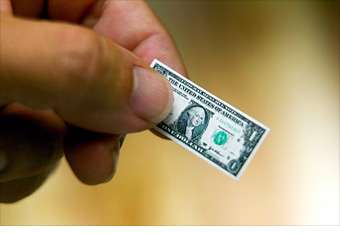Jim Rickards, author of the best-seller Currency Wars, sees the world’s central banks embroiled in a “race to debase” their currencies in order to restore – at any cost – growth to their weakened economies.
In the midst of the fight, the U.S. Federal Reserve wields oversized power due to the dollar’s unique position as the global reserve currency. As a result, actions by the Fed create huge percussive ripples across the battlefield, often influencing events in ways little understood by the players – and especially by the Fed itself.
In Rickards’ words, the policymakers at the Fed “think they are dialing a thermostat up and down, but they’re actually playing with a nuclear reactor – and they could melt the whole thing down”:
It will play out in all markets. When I say collapse, it is a loss of confidence in paper money.
Take the Fed, for example. The Fed has printed almost $3 trillion since 2007. Now, that is without a liquidity crisis. I mean, we did have a liquidity crisis in 2008. And the first round – I would say QE1 was a legitimate central-bank response to liquidity crisis. But QE2 and QE3: we will look back over them and we will see them as enormous blunders in one of the greatest failed experiments in economic history.
But the problem is, the Fed printed trillions of dollars without a liquidity crisis. What is going to happen when we do have a liquidity crisis, which I expect in the next couple years, where there is a 2008 panic starting again? What are they going to do? Print $6 trillion? $9 trillion? There is a limit on what they can do. And so at some point, it is going to get handed over to the IMF, and they are going to have to print SDRs (special drawing rights). That is the IMF world money. Because none of the central banks have clean balance sheets at this point; they look like hedge funds.
And so it really is a loss of confidence. Confidence is the key word – a loss of confidence in paper money. And that confidence is going to have to be restored somehow. And there are really only two ways.
One is the SDR, which no one understands. So maybe they can re-liquify the world by printing SDRs and that will create massive inflation, but no one will really understand where it is coming from.
And the other way is gold, which would restore confidence. But to have a non-deflationary price of gold, you are looking at $7,000 an ounce — very possibly higher, maybe as high as $9-10 thousand an ounce. I know that sounds extreme. But it is really just eighth-grade math, if you look at the money supplies and look at the physical amount of gold. People say you cannot have a gold standard because there is not enough gold. Well, that is not true. There is always enough gold; it is just a question of price. So the theoretical question is, what is a non-deflationary price for gold if you have to go back to a gold standard? And the answer is, it’s north of $7,000 and up.
So that is the kind of thing that you might see. It is not what any central bank wants. It is not what the elites want. But it is the kind of thing you could get if you had to restore confidence. So that is what the future of the international monetary system will look like. But right now, the Fed is still behind the wheel, and they are still driving the bus over the cliff.
Source: PeakProsperity





